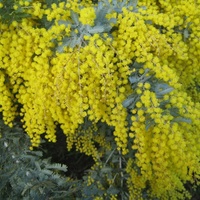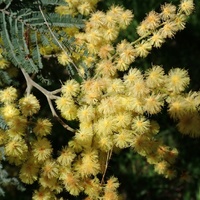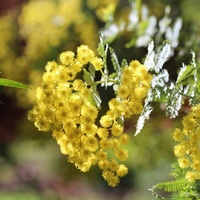Common name: Bailey's wattle
Other common names: Cootamundra wattle
Description
Native to Australia, this flowering shrub to small tree is typically 3 to 5 m (10 to 16 ft) tall, occasionally reaching heights of up to 9 m (30 ft). In shrub form, it is multi-trunked and low-branching. Otherwise, it has a single trunk supporting a rounded crown of drooping branches. The bark is smooth and grey or grey-brown.
The leaves consist of numerous blue-grey leaflets in a feathery arrangement. Their unusual colour adds contrast and interest to the masses of showy, yellow puff-ball-like flowers that bloom from late winter through spring. The flowers give off a sweet fragrance, with a scent that reminds one of honey and are followed by brown-black seedpods that mature in late summer.
Use
It is cultivated mainly in gardens for its showy flowers and sweet fragrance. The flowers produce god amounts of pollen which helps sustain brood-rearing honeybees in winter.
Flowering stems are cut for floral arrangements. Suitable stems have less than half of their flowers open, with the rest still at the bud stage but already yellow-coloured.
Climate
Grows and flowers reliably in sub-humid subtropical and tropical mid- to high-elevation climates, generally areas with annual lows of 7 to 17°C, annual highs of 17 to 30°C, annual rainfall of 200 to 1200 mm and a dry season of 8 months or less.
Growing
New plants are usually started from seed that germinate readily.
It is tolerant of a wide range of moist, free-draining clay, loam and sand soils of a moderately acid to neutral nature, generally with a pH of 5.5 to 7.0. Being a nitrogen-fixing plant, it will thrive on nutrient-poor soils.
Pruning each year after flowering helps to improve flowering performance the following year. A relatively short-lived tree species, it has a lifespan of just fifteen to twenty years.
Problem features
Seed-eating birds are known to disperse the seed outside of cultivation. It also re-seeds readily and is reported as a problem weed in California, South Africa, Zimbabwe, and in other regions where it is introduced, probably originally as an ornamental. Ironically, it is declared a noxious weed in Australia, where it is native.
The vigorous roots can block sewer and other underground pipes. A minimum planting distance of six meters from underground pipes is recommended.
Where it grows
References
Books
-
Allen, O. N. & Allen, E. K. 1981, The Leguminosae : a source book of characteristics, uses, and nodulation, University of Wisconsin Press, Madison, Wisconsin
-
Barwick, M., et al. 2004, Tropical & subtropical trees : a worldwide encyclopaedic guide, Thames and Hudson, London
-
Burke, D. 2005, The complete Burke's backyard : the ultimate book of fact sheets, Murdoch Books, New South Wales, Australia
-
Church, G. & Greenfield, P. 2002, Trees and shrubs for fragrance, David Bateman, Auckland, New Zealand
-
Clemson, A. 1985, Honey and pollen flora, New South Wales Department of Agriculture, Inkata Press, Melbourne
-
Editors of Sunset Magazine 2012, The New Western Garden Book: The Ultimate Gardening Guide, 9th edition, Sunset Publishing Corporation, California
-
Holliday, I. 2002, A field guide to Australian trees, 3rd revised editon, New Holland Publishers, Frenchs Forest, New South Wales
-
Jones, R. 2001, Caring for cut flowers, 2nd ed, Landlinks Press, Victoria, Australia
-
Leech, M. 2013, Bee Friendly: A planting guide for European honeybees and Australian native pollinators, Rural Industries Research and Development Corporation (RIRDC), Canberra, Australian Capital Territory
-
Macoboy, Stirling 1982, Trees for flower and fragrance, Lansdowne Press, Sydney
-
Maslin, B. R. & McDonald, M. W. 2004, Acacia Search : Evaluation of Acacia as a woody crop option for southern Australia, Rural Industries Research and Development Corporation (RIRDC), Barton, A.C.T., Australia
-
Mathias, M. E., 1982, Flowering plants in the landscape, University of California Press, Berkeley
-
National Research Council (Board on Science and Technology for International Development) 1979, Tropical legumes : resources for the future, The National Academies Press, Washington D. C.
-
Perry, B. 2010, Landscape plants for California gardens: an illustrated reference of plants for California landscapes, Land Design Publishing, Claremont, California
-
Randall, R. P. 2007, The introduced flora of Australia and its weed status, Cooperative Research Centre for Australian Weed Management, Glen Osmond, South Australia
Articles, Journals, Reports and Working Papers
-
South East Water Company 1999, Tree roots : a growing problem, South East Water, Moorabbin, Victoria




